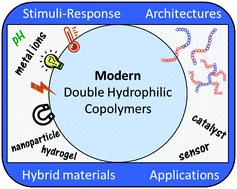Double hydrophilic copolymers – synthetic approaches, architectural variety, and current application fields
Abstract
Solubility and functionality of polymeric materials are essential properties determining their role in any application. In that regard, double hydrophilic copolymers (DHC) are typically constructed from two chemically dissimilar but water-soluble building blocks. During the past decades, these materials have been intensely developed and utilised as, e.g., matrices for the design of multifunctional hybrid materials, in drug carriers and gene delivery, as nanoreactors, or as sensors. This is predominantly due to almost unlimited possibilities to precisely tune DHC composition and topology, their solution behavior, e.g., stimuli-response, and potential interactions with small molecules, ions and (nanoparticle) surfaces. In this contribution we want to highlight that this class of polymers has experienced tremendous progress regarding synthesis, architectural variety, and the possibility to combine response to different stimuli within one material. Especially the implementation of DHCs as versatile building blocks in hybrid materials expanded the range of water-based applications during the last two decades, which now includes also photocatalysis, sensing, and 3D inkjet printing of hydrogels, definitely going beyond already well-established utilisation in biomedicine or as templates.



 Please wait while we load your content...
Please wait while we load your content...